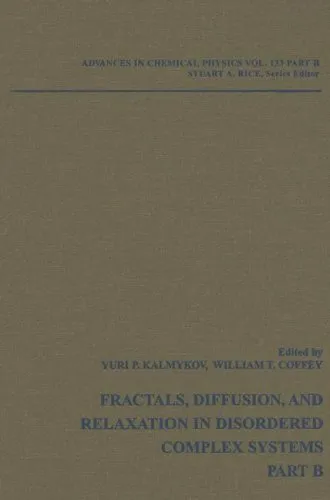Advances in Chemical Physics, Vol.133, Part B. Fractals, Diffusion, and Relaxation (Wiley 2006)
4.5
Reviews from our users

You Can Ask your questions from this book's AI after Login
Each download or ask from book AI costs 2 points. To earn more free points, please visit the Points Guide Page and complete some valuable actions.Introduction to "Advances in Chemical Physics, Vol.133, Part B: Fractals, Diffusion, and Relaxation"
"Advances in Chemical Physics, Vol.133, Part B: Fractals, Diffusion, and Relaxation" delves into the intricate and fascinating world of chemical physics, providing readers with a comprehensive exploration of contemporary research on fractals, diffusion mechanisms, and relaxation phenomena. Published in 2006 by Wiley, this volume has been co-authored by Stuart A. Rice, Yuri P. Kalmykov, and William T. Coffey, three eminent scholars who bring their extensive expertise to the table. Part of the renowned "Advances in Chemical Physics" series, this book continues the tradition of presenting innovative, cutting-edge research to those immersed in the field of chemical physics.
Detailed Summary of the Book
This book is a rich resource for researchers and professionals in chemical physics and allied disciplines who seek to understand complex dynamics on a molecular level. The authors adopt a multidisciplinary approach to illustrate how fractal geometries influence diffusion and relaxation processes across diverse chemical and physical systems.
Covering topics from stochastic dynamics to non-equilibrium statistical mechanics, this volume emphasizes the pivotal role fractal structures play in determining the dynamics of particles in heterogeneous media. The content is split into detailed chapters that discuss theoretical models, experimental findings, and practical implications drawn from numerous fields, including condensed matter physics, materials science, and biophysical chemistry.
The emphasis is placed on processes such as anomalous diffusion, where particle motion deviates significantly from standard Brownian motion, and non-Debye relaxation, which challenges conventional exponential laws. Concepts such as scaling, memory effects, and time-dependent transport phenomena are addressed with rigor and clarity. Each chapter provides extensive mathematical treatments for the phenomena described, supplemented by examples and case studies demonstrating their applications in real-world contexts, such as polymers, glasses, and biological systems.
Key Takeaways
- Fractal geometries profoundly influence molecular dynamics, resulting in unique diffusion and relaxation behaviors.
- The book bridges the gap between theoretical modeling and experimental results, ensuring a well-rounded understanding of complex systems.
- Both time-dependent and frequency-dependent relaxation mechanisms are explored, offering insights into non-conventional systems.
- The mathematical framework provided in the book equips researchers with tools to further research in stochastic processes, memory effects, and scaling behaviors in complex environments.
- Applications of fractal dynamics extend beyond chemical physics, influencing fields such as materials science and biomedical research.
Famous Quotes from the Book
"The study of fractals and dynamics within heterogeneous systems challenges not only the paradigms of classical physics but also the ways in which we model real-world systems."
"Relaxation and diffusion processes, whether they occur in glasses, biological cells, or polymeric materials, reveal profound non-linearities that require novel frameworks for understanding."
Why This Book Matters
"Advances in Chemical Physics, Vol.133, Part B: Fractals, Diffusion, and Relaxation" stands as a cornerstone for any professional or academic looking to deepen their understanding of chemical and physical dynamics in complex systems. With its sharp focus on fractals, this volume offers a fresh perspective on why certain materials and systems deviate from classical theoretical predictions.
Beyond chemical physics, this book is of significant importance to interdisciplinary research. Its principles and findings find resonance in materials science, biology, nanotechnology, and even environmental science. For instance, the work on anomalous diffusion is vital for understanding drug delivery mechanisms, while insights into relaxation dynamics pave the way for advancements in the design of high-performance materials.
Combining intellectual depth with practical applicability, this book ensures that readers walk away not only with a deeper theoretical understanding but also new ideas for experimental approaches. It is a must-read for those at the forefront of research in chemical and physical sciences, as well as those aspiring to join this fascinating domain.
Free Direct Download
Get Free Access to Download this and other Thousands of Books (Join Now)
For read this book you need PDF Reader Software like Foxit Reader


